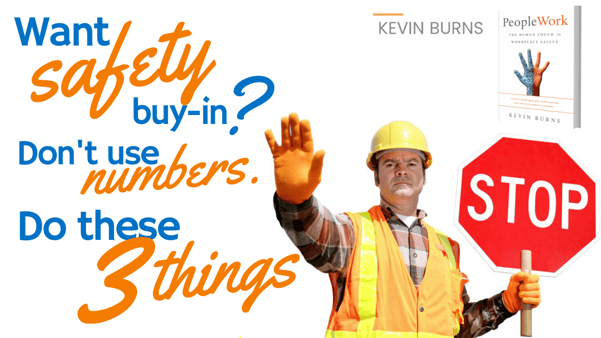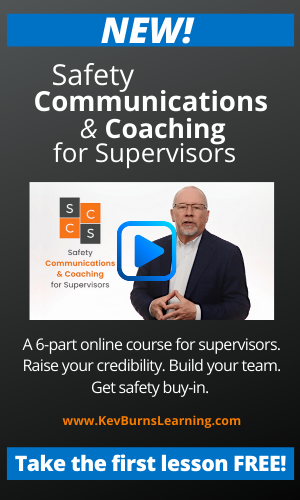Want safety buy-in? Stop using numbers. Do these 3 things.
 Safety numbers don’t matter … to front-line employees. They matter to you and your senior management team. Maybe to the finance department and of course to your sales and marketing department, but that’s where numbers stop mattering.
Safety numbers don’t matter … to front-line employees. They matter to you and your senior management team. Maybe to the finance department and of course to your sales and marketing department, but that’s where numbers stop mattering.
Here's where I learned that numbers don't matter. Once upon a time, I was in photocopier sales. Our sales manager was a young and aggressive guy who had worked himself up through the sales ranks to a management position. Like most workplaces, ours took the best salesperson and made him manager. But without developing his coaching and mentoring skills, his track record in sales didn’t translate into helping inexperienced sales reps.
At the weekly sales meeting, each member of the sales team was asked to declare their “number:” how many cold-calls each of us would make that week. It was based on a company-wide formula that for every 20 cold-calls, we would on average uncover 4 potential customers who would request a proposal/quote. Out of the 4 proposals, we would have the chance to demo 2 photocopiers (that means leave the machines in a customer location for a week or so for them to get a hands-on experience – and hopefully fall in love with it). For each 2 demos, we would sell one copier. Make 20 cold-calls, sell one machine. That was the formula.
Talk of numbers doesn’t equip a front-line employee to be more diligent in looking out for his or her co-workers.
Each sales rep would have to declare a number (truthfully, the boss deep-down wanted each of us to do 20 cold-calls a day as a minimum). Except that he never followed-up our made-up target numbers. He asked for a number. We all made one up. No one was ever held to account for their number. The exercise was meaningless. Now, here's where you discover how the numbers you are setting for safety goals are also meaningless.
Safety meeting numbers aren’t helping.
Perhaps you’ve sat in on more than a few safety meetings that featured wall-to-wall numbers. Month by month graphs and charts of totals of First Aids, Medical Aids, TRIF and LTIs. Then there’s the whopping Near-Miss numbers. And even though these numbers eat up a lot of time during the meetings, most of it is meaningless to the front-line employee.
In safety meetings, numbers are used as padding and filler to eat up a chunk of time or to prove that all those forms and paperwork actually add up to something. Unless you’re giving a financial report, which is all about the numbers, give the numbers a rest if you’re trying to get buy-in from your people.
Talk of numbers doesn’t help a front-line employee look out for his or her co-worker any better. Numbers don’t help employees motivate themselves to be more willing to follow protocols or to be proactive in housekeeping. Numbers don’t inspire people to want to work better anymore than a review of numbers would inspire a professional sports team to go win the final game and a championship.
If you'd like to get at leading, motivating and inspiring your team to buy-in to the vision, then take the Free Preview of the Safety Communications & Coaching for Supervisors course. 40-minutes of video instruction, summary sheet download PDFs and a companion MP3 audio version to take with you on the go. And it's free to get started.
Three strategies better than safety numbers.
Reciting numbers doesn’t make your people want to perform better in the moment. So, here are three things you should be doing to get yourself focused while driving more focus and motivation for your team.
- Identify your intent for the team. What do you want your people to do differently or better as the result of your meeting? The purpose of a safety meeting isn’t to review numbers. The purpose is to ready your people to give their attention and focus to the way they are working, the way they are looking out for each other, and in feeling proud of delivering their best performance. When everyone is delivering their best performance, you have very few concerns around safety. So, identify your intent and what you want to accomplish with your safety meeting. Every word you use should deliver something tangible that your people can use to better themselves and their team. Numbers don’t do that.
- Treat your safety meeting like a pre-game, dressing-room team speech. You are the coach. Your team is about to hit the field. You are playing your worst opponent today: injury and incident. There is no way that you are going to allow injury and incident to get any sort of win. This is your house. You need to make sure your guys are physically and mentally prepared to go out there and win for themselves. Injury and incident are just waiting for you to make a mistake so they can get a win. Not in your house. Not on your watch. A winning team stands up for and protects each other.
- Take a 30-second timeout. Sports have a limited number of timeouts. You do not. You have an unlimited number of timeouts. You can call a timeout as many times a day as you feel necessary to make sure that your team is still focused on-task and has still got high levels of motivation. In fact, good coaches know exactly when to call a timeout for their team. Use your timeouts to get buy-in on a short-term goal and especially if something or someone new is entering your workspace. Never assume your people know what to do. Call your timeout and use it to get your team focused and on-task.
-- Take the FREE preview lesson of Kevin's course Safety Communications & Coaching for Supervisors. 40-minutes of video instruction, summary download PDFs and a companion audio MP3 version to take with you on the go. SCCS is an online course to help energize safety, build teamwork, and get employee buy-in.
Take the FREE preview lesson of Kevin's course Safety Communications & Coaching for Supervisors. 40-minutes of video instruction, summary download PDFs and a companion audio MP3 version to take with you on the go. SCCS is an online course to help energize safety, build teamwork, and get employee buy-in.
Kevin Burns, consultant/author, works with smart, caring companies to energize safety culture, build teamwork, and get employee buy-in.
KevBurns Learning is committed to to helping companies improve safety by improving people, through creative learning materials, virtual strategy sessions, safety meeting presentations, and team coaching programs.
In 2020, BookAuthority.org named PeopleWork #7 of The Top 44 Workplace Safety Books of All Time. Buy yourself a copy of PeopleWork: The Human Touch in Workplace Safety and give another as a gift to a colleague.
Subscribe to Kevin's YouTube channel.
Subscribe to Kevin’s Blog.


